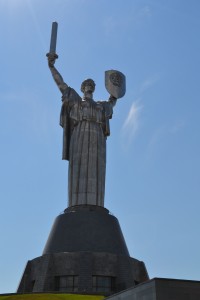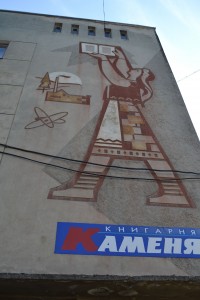This post is republished from Canonball, a feminist blog I contributed to a few years ago. It is reproduced here for some background about my theoretical framework for this research, particularly why I see gender issues as so central to my project.
Anthropologists and others have long been under the impression that we can better understand our own society if we delve into others’ worlds. Initially, this meant anthropologists studied “simple” societies with the hope that their social structure would be a model of our own. Even though we’ve since recognized that this is a problematic hierarchy, the initial assertion holds true. And perhaps more now than ever before: in an increasingly complex, interconnected, and fast-paced world, no society or issue exists in a bubble.
I think this includes gender politics. As many have proven, feminism exists in infinite forms and for infinite reasons. There are concrete reasons for this. As discussed before with Christine Ward Gailey’s article, studying gender always means recognizing the real, concrete life situations of people. These situations vary over time and space. And the one I’m most interested in right now is the context of postsocialism in Eastern Europe/former Soviet Union.
I tend to be a bit of an idealist about socialism — that is, I admire countries whose governments are able to implement social welfare programs that benefit all citizens. But the economic situation that is socialism, particularly as it was implemented by Party states during the 20th century, had major impacts on gender roles both during and after state socialism. This has put postsocialist women in very precarious positions, and it has also placed any Western idea of “feminism” in a marginal category. I think that Western feminists can learn a lot from the experience of these postsocialist women — but first we need to understand how socialism worked in such a way that it produced gender categories and roles that both emancipated and disadvantaged women.
In order to do this, I turn to two seminal works in the anthropology of Eastern Europe (an area, I might add, which is largely dominated by women!): Katherine Verdery’s What Was Socialism, and What Comes Next? and Susan Gal & Gail Kligman’s The Politics of Gender After Socialism. I’m only going to focus on Verdery’s first chapter, “What Was Socialism, and Why Did It Fall?” which you can read online (www.faculty.fairfield.edu/dcrawford/verdery.pdf).
Verdery suggests that the socialist states — rather than being the all-powerful, totalitarian entities that the Cold War proponents told us they were — were actually quite fragile and had difficulty gaining legitimacy from their citizenry. There was constant opposition, and seemingly small forms of internal resistance were made easy because of the way the economy worked.
In a socialist economy, the focus is on the center, the locus of control. This center decides everything: what people need, how those items should be made, who should do the work, and what happens to the product. The more the center controls, the better the system should function. Unfortunately, under state socialism, the center couldn’t actually perfectly administer the production of everything. This meant that individuals — managers, workers, and bureaucrats alike — took steps to secure their own well-being, at the detriment of the well-being of the state. In turn, this challenged the state’s ability to redistribute goods to citizens. The promise to meet people’s needs was the guarantee on which the state’s legitimacy was based, but without total control of production, such a promise couldn’t always be kept.
Plus, a “state” isn’t an animate entity in itself. It is made up of people who are expected to behave in a certain way in order to ensure its well-being. And this played out in a unique way in terms of gender roles. Men were expected to work, but they were not meant to be providers — that role belonged to the state. Women, on the other hand, were expected to work, but their work was twofold. As equals to their male counterparts, they would participate in the labor force, but they were also held to their roles as mothers and homemakers. Their reproduction was regulated by the state — for example, in Ceauşescu’s Romania, abortion was outlawed for everyone in order to protect the country’s “national essence.” They were expected to devote themselves to the socialist movement as well as to a nationalist one. As providers for the state and for their families, they held what many have called the “double burden.” In return, the state would (theoretically) protect them with social assistance and basic needs.
But, as we all know, things didn’t quite turn out. According to Verdery, state socialism failed because of a confluence of internal and external changes. As I described earlier, the paternalistic state didn’t function perfectly. When some officials realized how detrimental this would be to the Party state, they implemented reforms that opened their markets to Western capitalist economies, all in the name of attempting to preserve an internally socialist system. But the dual economy they had envisioned — which would combine the central redistributive mechanism of the Party state with interactions on the capitalist free market — was unsustainable at that particular moment in world capitalism. State socialism was no longer tenable after 1989, and the changes that followed its fall had incredible implications, particularly for women.
With stories of autocratic rule, citizen oppression, and failed states dominating the media, Western feminists were surprised at the lack of feminist action after the fall of state socialism. The thinking goes that as soon as women realized they were at a disadvantage after socialism, they should have taken to the streets to demand their equal rights, as Western feminists did. But these post-Communist women’s problems differed significantly from those of Western feminists, as the market transition meant the loss of social benefits and, for many, jobs.
Put simply, women who lived under socialism didn’t have the same concerns as Western feminists in 1989. They weren’t interested in the right to work or gaining autonomy from men — those had been guaranteed and strongly enforced by the Party state. They didn’t need political emancipation: socialist policies instituted quotas for women’s equal participation, although the parties were actually dominated by men. Currently, there is a suspicion of national politics and significantly fewer numbers of women participating in politics. But Gal & Kligman suggest this should not be as alarming as Western feminists make it out to be: obligatory political participation — as existed under socialism — is not equal rights. Furthermore, women don’t have to participate in national politics to be politically active.
Socialist women after 1989 had a completely different structural position from that of Western women, which the latter failed to recognize. Western feminists’ assumption of postsocialist women’s feminism seemed like a new kind of imperialism, and it has stigmatized “feminism” in the postsocialist context. They had spent their entire lives participating in various (state-sponsored) social movements — what would make them want to dedicate themselves to a new one, particularly one being imposed by others?
Of course, no group of women is monolithic. There are certainly some who have adopted Western feminism, some who have appropriated feminism to their context, and some who actively participate in women’s issues without calling themselves feminists. Gal & Kligman are smart to remind us that “political solidarity cannot be assumed on the basis of shared ‘womanhood’” (106). As I hope to explore in future posts, postsocialist women are doing all sorts of political action, with varied responses from women and men alike. I think if we continue to explore various contemporary contexts, we can better frame our own — and potentially create more relevant change because of it.
Further reading
Gal, Susan and Gail Kligman. 2000 The Politics of Gender After Socialism. Princeton: Princeton University Press.
Verdery, Katherine. 1996 What Was Socialism, and What Comes Next? Princeton: Princeton University Press.



